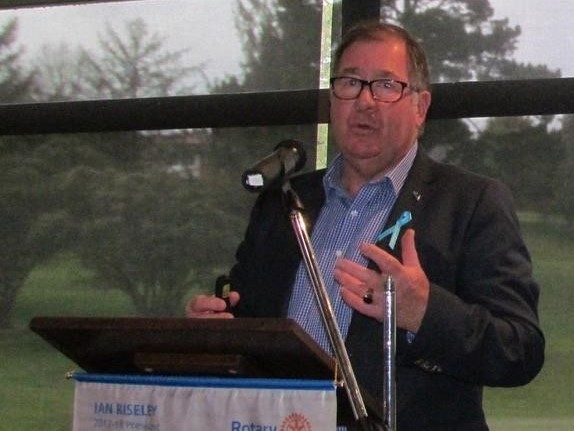 Warning
WarningThis report contains words and information some members may find disturbing!!!
Graeme opened by explaining the Prostate Cancer Foundation in NZ has been in existence for around 20 years and started as a voluntary organisation. Around five years ago the Board made a strategic decision to establish a National office in Auckland. The original team of two has now grown to six. The Foundation deals not just with Prostate Cancer (known as an ‘older men’s disease’) but also Testicular Cancer (‘younger men’s disease’). To generate awareness of Testicular Cancer, for the first time this year the “Go Balls Out” campaign was rolled out. The campaign asked the public to create cock and ball maps across the New Zealand landscape by using an exercise app such as MapMyWalk. Once the walk (aka cock and ball masterpiece) was created, the idea was to take a screenshot of it and share this with the hashtag #goballsout and tag goballsout.org.nz. Thanks to social media the campaign went viral (reaching 190 countries) and created superb awareness of this particular cancer which kills more young Kiwi men than any other cancer. (We dare you to Click onto the link for more...)
Graeme then presented us with some alarming NZ statistics:
- 647 men a year die from Prostate cancer
- 633 women a year die from Breast cancer
- 253 people a year die from road accidents
- 54 women a year die from cervical cancer
- 3000 NZ men are diagnosed with Prostate cancer every year
Despite the numbers above, the Government contributes nothing toward Prostate Cancer awareness. In the last decade, more men have been diagnosed with Prostate Cancer, than women have been diagnosed with Breast Cancer. Prostate Cancer is not just an ‘older men’s disease’. Young men are susceptible and it tends to be more aggressive for younger men. Graeme shared with us the story of Danny who was diagnosed at the age of 37. His father had died of Prostate Cancer. If you are a male and your father or brother has been diagnosed; your risk to get this disease is doubled.
- 1 in 8 men will get Prostate Cancer in their life time
- More men get Prostate Cancer than women get Breast Cancer
- If you are over 50 – get checked annually
- If you are over 40 and there is a family history of this cancer, your risk is doubled
Graeme than gave us a simplified but enlightening anatomy lesson, particularly useful for the uninitiated:
- The Prostate gland produces semen and controls erections
- It is an integral part of men’s sexual function
- The gland is about the size of a walnut and enlarges to granny-smith apple size with age
- It is the age-related enlargement of the gland that often creates urinary problems
- Not all men’s urinary problems are related to Prostate cancer
- The digital rectal examination is the only way to “feel” the Prostate gland
- Colonoscopies cannot detect prostate cancer
Signs and Symptoms of Prostate Cancer
In the early stages, there could be no symptoms. In the later stages, symptoms might include:
- Feeling the frequent or sudden need to urinate
- Trouble starting to urinate
- Not being able to urinate
- Poor flow
- Discomfort when urinating
- Finding blood in urine or semen
- Pain in the lower back, upper thighs or hips
How is prostate cancer detected and diagnosed?
- Blood test - Prostate Specific Antigen [PSA] test
- Digital Rectal Examination [DRE]
If the tests show you may be at risk, the next step is a biopsy which is the only way a definitive diagnosis can be made. The biopsy is usually done as an out-patient procedure.
Graeme’s message was clear. For our gentlemen: Don’t dick about! Man-up and talk to your doctor about testing for prostate cancer using the PSA test and DRE as part of your annual health check-up. And Ladies, don’t let your menfolk wimp out. Talk about Prostate Cancer and insist these checks become part of their health regime at the appropriate age.
For full information www.prostate.org.nz